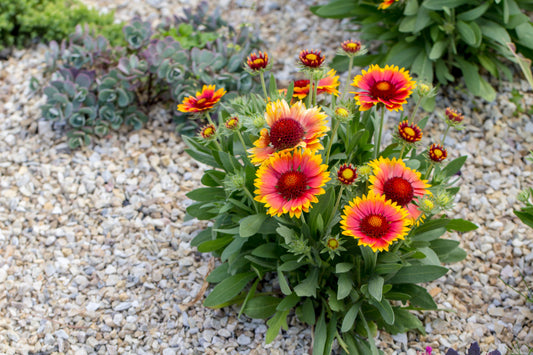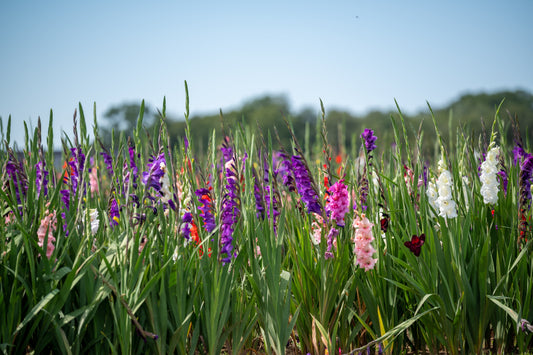Lilium Planting & Growing Guide
Planting Guide Information
-
Species dependent; 4-6"Planting Depth
-
Species dependent; 8-18"Planting Proximity
-
Fall or SpringPlanting Season
-
Lilium offers fragrant blooms that are a favorite! Roselilies are pollen-free too!Plant Benefits
-
ModerateWater Quantity
-
Late Spring through SummerBloom Season
-
Full to Partial SunSunlight Quantity
-
Species dependent; Zones 4-9Hardiness Zones
Additional Growing Information
Where to Plant
While Lilies are remarkably easy to grow in the ground and in containers, plenty of sunlight and well-drained soil will make them happiest. If you notice puddles of water 5–6 hours after a hard rain, scout out another site or amend the soil with organic material to raise the level 2–3 inches. They also fancy areas that are sheltered from high winds.
When to Plant
Lilies can be planted in the fall or early spring and tend to bloom from early summer to fall, depending on the variety. In many regions, Lilies are best planted in the fall at least four weeks before the ground freezes. These stunning plants favor cool soil, so for those planting in early spring, be sure to start when the ground is workable but not muddy.
How to Plant
- For outdoor landscape planting, find a full sun location that provides shelter from high winds and dig holes 8–18" apart. Place the bulbs with their tops 4–6" below the soil surface and the slightly pointy end facing up.
- For container planting, choose a container with adequate drainage holes that's large enough to accommodate your plant's mature size and fill it with good quality, well-drained soil. Dig holes and plant your Lilies close to each other with hips roughly 4" apart. Tuck them down 4–6" inches into the soil with the bulbs' pointy part facing upwards.
- Water thoroughly, soaking the soil to settle it around the bulbs.
How to Grow
- Water as needed during active growth periods; about 1" of moisture per week is a fair estimate.
- Apply mulch around the plant to keep the roots cool and moist, but not wet, during active growth.
- Apply a high-potassium fertilizer every couple of weeks from planting until roughly 6 weeks after flowering.
- Leave the foliage in place after blooming has finished for the season. The leaves will gather sunlight to create food through photosynthesis, strengthening the bulb for the future.
- Remove foliage and decrease watering when the leaves turn yellow and die back as your Lilies slip into dormancy.
Lily Tips & Tricks
- Amend soil with the addition of compost, finely ground bark, or decomposed manure to raise the level 2–3 inches to improve the drainage.
- Plant shorter Oxalis with Lilies in the same container, as they make good partners and will put on a brilliant display.
- Choose different varieties of Lilies to stretch the blooming season from early summer into early fall.
- Bear in mind that some types of Lilies reseed and expand into large, colorful patches.
- Feel free to snip a few stems while in bloom, as these beauties make lovely cut flowers for bouquets and other arrangements. Cutting will not harm the plants, provided they are given a little fertilizer later in the season to help provide strength for future seasons.
- Purchase your bulbs close to planting time, as Lily bulbs will deteriorate over time.
- Ensure that your Lily bulbs never sit in waterlogged soil, as they will rot.
- Expect roots to grow a week or two after planting and sprouts to emerge the following spring.
From the Family
-
 50% Off
50% OffLilium - Asiatic Lily Mix
12 Lily BulbsRegular price $17.98Sale price $17.98 Regular priceUnit price per$35.9550% Off -
Lilium - Asiatic Lily Bright Diamond
3 Lily BulbsRegular price $7.17Sale price $7.17 Regular priceUnit price per$11.9540% Off -
 40% OffBOGO
40% OffBOGOLilium - LA Hybrid Lily Arbatax (Fragrant)
3 Lily BulbsRegular price $7.17Sale price $7.17 Regular priceUnit price per$11.9540% OffBOGO -
Lilium - Oriental Lily Casa Blanca
3 Lily BulbsRegular price $7.77Sale price $7.77 Regular priceUnit price per$12.9540% Off -
 40% Off
40% OffLilium - Oriental Lily Stargazer
3 Lily BulbsRegular price $7.77Sale price $7.77 Regular priceUnit price per$12.9540% Off








